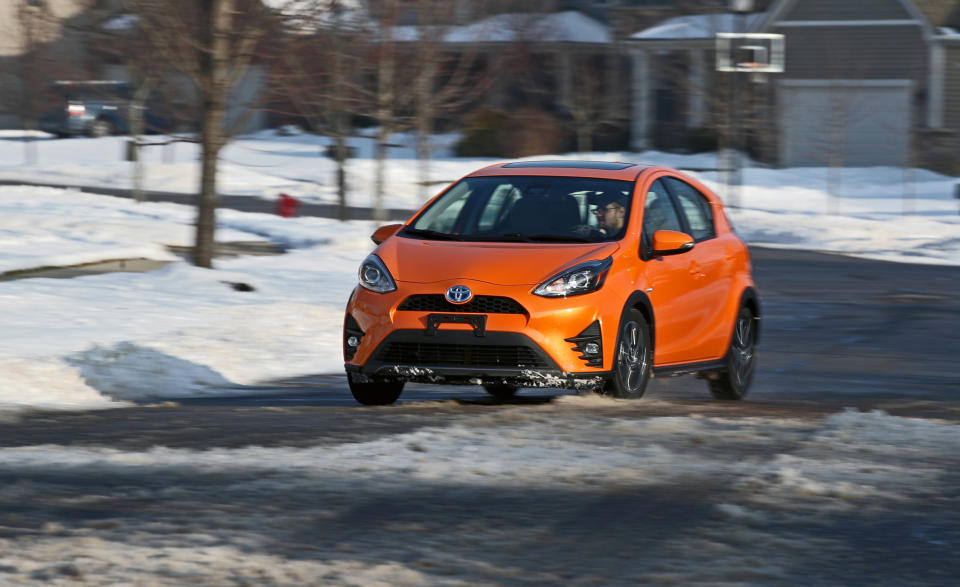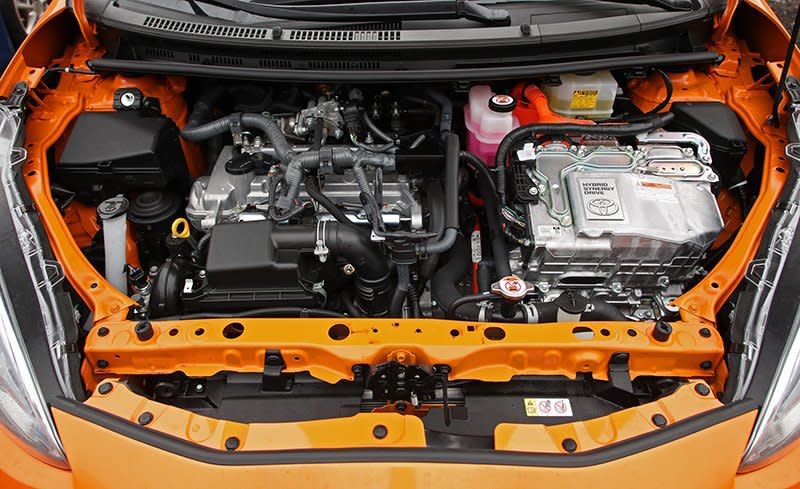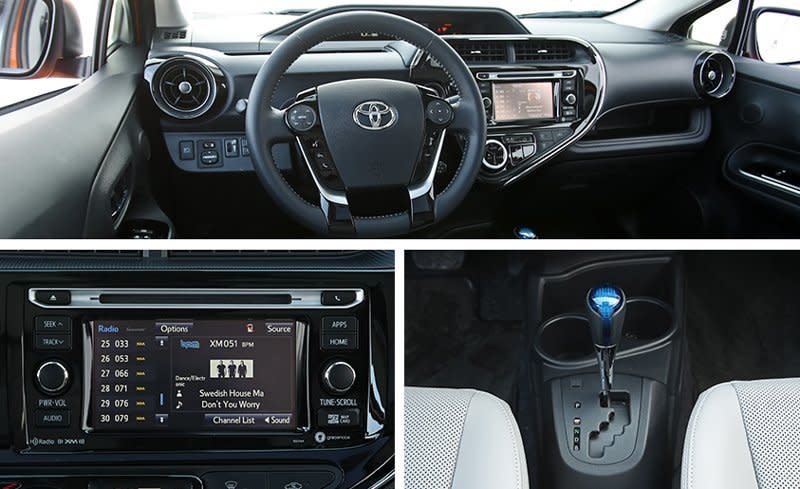2018 Toyota Prius C

Back in 2012, when a gallon of 87 octane topped $3.60, the Toyota Prius C was a sensible addition to the Japanese automaker’s lineup. Building on the fuel-efficient principles of the Prius gasoline/electric hybrid model line, the Yaris-based Prius C advertised a combined 50 mpg EPA estimate in a sub-$20,000 package—that was 17-mpg greater than the most efficient Yaris at the time, albeit at a price almost $5000 dearer than that of Toyota’s entry-level model.
A half-dozen years later, though, the Prius C comes across as a less compelling choice. With the national average for a gallon of gas at well under $2.60, the littlest Prius lacks the cost-conscious appeal it once had. Adding insult to injury, Toyota’s smallest hybrid vehicle is no longer as inexpensive and can no longer tout that 50-mpg figure—mostly because the EPA implemented tougher fuel-economy testing guidelines. With a starting price of $21,525, the Prius C now bears an EPA-estimated combined fuel-economy figure of 46 mpg.

The Prius C relies on the same powertrain as it did in 2012. Consisting of a 1.5-liter inline-four and a pair of AC motor/generators, the Prius C’s hybrid system musters a combined 99 horsepower and drives the front wheels by way of an electronically controlled continuously variable automatic transmission (CVT). As in Toyota’s other hybrid vehicles, the smaller of its two electric motors sets the drive ratio to convey the combustion engine’s grunt to the ground. Meanwhile, the larger second motor is geared directly to the final-drive differential and provides propulsion, as well as electricity regenerated during deceleration.
Electricity is supplied to the two motors courtesy of a 0.9-kWh nickel-metal-hydride battery pack mounted under the rear seat, and an EV mode allows the Prius C to travel on electricity alone for up to a mile at low speeds, provided the operator has an exceedingly light right foot.
Lean Not Mean
In spite of its slim 2644-pound curb weight, the Prius C is downright slow. The one we tested needed a glacial 11.4 seconds to amble from zero to 60 mph and 18.2 seconds to cross the quarter-mile mark at 75 mph. Its lethargy is exacerbated by the CVT, which causes the engine to drone in making the most of the meager 73 horses the inline-four produces at 4800 rpm. A small bit of solace comes from the immediacy of the electric motors’ 125 lb-ft of torque, with the Prius C going from zero to 30 mph in a reasonable enough 3.3 seconds.

Boot the accelerator pedal at speed, though, and the Prius C moves with the alacrity of a three-toed sloth. Getting from 50 to 70 mph takes 8.3 seconds, or 0.4 seconds longer than a CVT-equipped, three-cylinder Mitsubishi Mirage hatchback. The $15,490 Mitsubishi also manages to match the hybrid Toyota’s 43 mpg highway EPA estimate, a figure this Prius C test car equaled on our 75-mph highway fuel-economy test.
We averaged a mere 36 mpg overall from the Prius C over more than 550 miles of mixed use—that’s 10 mpg worse than the EPA’s combined rating and 3 mpg worse than we got in a 2012 test of a Prius C that weighed 47 pounds less (and was 0.5 second quicker to 60 mph). Our observed fuel economy was also no better than what we recorded for an automatic-equipped Toyota Yaris iA (née Scion iA). Additionally, the iA was both quicker and more enjoyable to drive than the Prius C thanks to the Mazda-based sedan’s engaging dynamics, feelsome steering, and clairvoyant six-speed automatic transmission.
The Prius C earns kudos for its brake pedal’s feel and modulation, which nicely blends regenerative and mechanical braking functions. In collaboration with its 15-inch Goodyear Assurance all-season tires, this Prius C stopped from 70 mph in 173 feet, 12 feet shorter than both a Yaris hatchback and the Yaris iA sedan. Weather conditions precluded our usual 300-foot skidpad test, but the last Prius C we puttered around it recorded a modest 0.79 g of grip.

Crossing Over
Unlike its mechanical bits, the exterior of the Prius C changed significantly for 2018, trading in its old wares for fresh and handsome crossover-SUV-inspired looks. Black wheel arches surround new 8-spoke wheels, while roof rails and new front- and rear-end treatments with faux skid plates give the Prius C a more rough-and-tumble mien. Redesigned LED head- and taillights add a hint of modernity to the aging hatchback.
Inside the Prius C welcomes piano-black plastic pieces on the dashboard and steering wheel. The smudge-friendly surfaces complement standard features such as automatic climate control, a 6.1-inch touchscreen infotainment system, and a steering wheel with integrated audio and Bluetooth controls. The ergonomically troubling center-mounted instrument cluster carries over, though, and the dashboard and door panels continue to be crafted from hard, low-rent plastic pieces.
The interior is surprisingly roomy given the Prius C’s small footprint, and the rear legroom even tops that of the larger Prius. The Prius C also provides a Honda Fit-matching 17 cubic feet of cargo space with all seats in place. A folding rear seat is standard.

Additional Prius C merits include standard advanced safety items such as automated emergency braking, lane-departure warning, and automatic high-beam headlamps. Getting convenience items such as cruise control, a 60/40 split-folding rear seat, and a cargo cover requires spending $22,325 on the pricier Prius C Two trim (the $21,525 Prius C One serves as the entry-level model).
A proximity key with push-button start and a navigation system are grouped into the $23,750 Prius C Three, while the top-of-the-line $25,860 Prius C Four includes heated exterior mirrors with integrated turn signals, LED fog lights, a sunroof, and faux-leather trimmed seats. Our Prius C Four test car also featured a $395 coat of Tangerine Splash Pearl orange paint and $224 worth of carpeted mats to bring its as-tested price up to $26,479—that’s $419 more than a well-equipped Toyota Prius Two Eco, a model that is rated by the EPA at 58 mpg in the city and 53 mpg on the highway. The bigger and quicker senior Prius offers eight cubic feet of extra cargo space, too.
There was a brief time when the Prius C had a purpose in Toyota’s lineup. However, its larger Prius stablemate has undergone more-extensive improvements and seems to represent better value. This junior edition is less interesting to drive than conventional subcompact models and offers insufficient fuel economy to offset that deficit. It’s not your best choice whether you’re scoring it as a hybrid or as a subcompact hatchback.
Specifications >
VEHICLE TYPE: front-engine, front-wheel-drive, 5-passenger, 4-door hatchback
PRICE AS TESTED: $26,479 (base price: $21,525)
ENGINE TYPE: DOHC 16-valve Atkinson-cycle 1.5-liter inline-4, 73 hp, 82 lb-ft; permanent magnet synchronous AC electric motor, 60 hp, 125 lb-ft; combined power rating, 99 hp; 0.9-kWh nickel-metal-hydride battery pack
TRANSMISSION: continuously variable automatic
DIMENSIONS:
Wheelbase: 100.4 in
Length: 159.8 in
Width: 159.8 in Height: 159.8 in
Passenger volume: 86 cu ft
Cargo volume: 17 cu ft
Curb weight: 2644 lb
C/D TEST RESULTS:
Zero to 60 mph: 11.2 sec
Zero to 100 mph: 45.3 sec
Rolling start, 5–60 mph: 11.4 sec
Top gear, 30–50 mph: 5.4 sec
Top gear, 50–70 mph: 8.3 sec
Standing ¼-mile: 18.2 sec @ 75 mph
Top speed (drag limited, C/D est): 105 mph
Braking, 70–0 mph: 173 ft
C/D FUEL ECONOMY:
Observed: 36 mpg
75-mph highway driving: 43 mpg
Highway range: 400 mi
EPA FUEL ECONOMY:
Combined/city/highway: 46/48/43 mpg

 Yahoo Autos
Yahoo Autos 